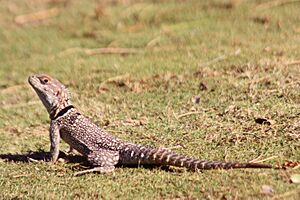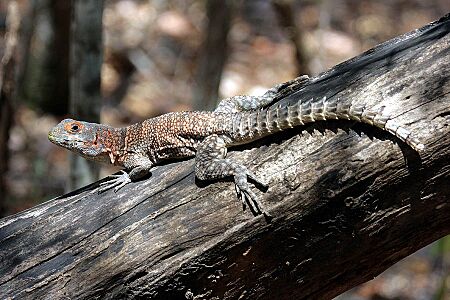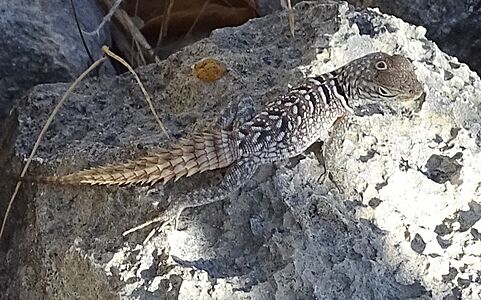Collared iguana facts for kids
Quick facts for kids Collared iguana |
|
|---|---|
 |
|
| At Anjajavy Forest, Madagascar | |
| Conservation status | |
| Scientific classification | |
| Genus: |
Oplurus
|
| Species: |
cuvieri
|
The Oplurus cuvieri, often called the collared iguana, is a type of lizard that mostly lives in trees. It belongs to the Opluridae family. These lizards are found in Madagascar and the Comoros islands. The collared iguana is the largest of the six species in its group, known as Oplurus. There are two recognized types, or subspecies, of this lizard.
Contents
What's in a Name?
The scientific name, cuvieri, was given to honor a famous French naturalist named Georges Cuvier.
Meet the Collared Iguana
As its name suggests, the collared iguana has a clear black collar around its neck. Its body is covered with lighter spots. It has a large head and a fairly short tail with spiny scales. Female collared iguanas are usually a duller brown color.
These lizards can grow to about 16 inches (40 cm) long. They typically weigh between 160 and 190 grams.
The pictures below show how much their markings and colors can change.
Where Do They Live?
The collared iguana lives in the western tropical forests of Madagascar. You can also find them on Grand Comore Island, which is part of the Comoros.
Different Types of Collared Iguanas
There are two main types of collared iguanas:
- Oplurus cuvieri cuvieri – This type lives in Madagascar.
- Oplurus cuvieri comorensis – This type lives on Grand Comore Island.
What Do Collared Iguanas Eat?
Oplurus cuvieri mostly eats meat. Their diet mainly consists of insects.
How Do They Behave?
These iguanas are active during the day. They spend most of their time in trees, gripping onto trunks and branches. They stay very still, looking around for insects to eat.
When a collared iguana spots its prey, it quickly runs to catch it. They have also been seen waiting near ant trails to easily pick up ants. Sometimes, they might also eat plants, like flowers.
This lizard likes to have its own space. You might find them alone or with one male and a few females in an area.
If a collared iguana feels threatened, it will hide in a crack or hole in a tree. It uses its tough, armored tail to block the entrance, protecting itself from danger.
Life Cycle of the Collared Iguana
Madagascar collared lizards are ready to have babies when they are about 2 to 3 years old.
They breed during the rainy season. Females lay their eggs right after the first heavy rain. Male iguanas will fight each other to get the attention of females.
The female digs a hole about four inches deep in open ground, away from plants. She lays about 2 to 5 eggs in this hole. Then, she fills the hole with sandy soil and covers it with sand, leaves, and twigs. This makes the nest blend in with its surroundings. After laying the eggs, the female leaves the nest. Neither parent takes care of the baby lizards. Females can lay several groups of eggs each year.
The eggs of the Madagascar collared lizard hatch after about 61 to 71 days.
Protecting the Collared Iguana
We don't have exact numbers for how many collared iguanas live in the wild. There are also no specific plans in place to protect them. However, their homes in the forests of Madagascar are facing many threats. These include forests being burned for farming and trees being cut down for wood and charcoal.
Also, because their nests are shallow and not protected, other reptiles often eat their eggs. The Malagasy giant hognose snake is one of their main predators.




